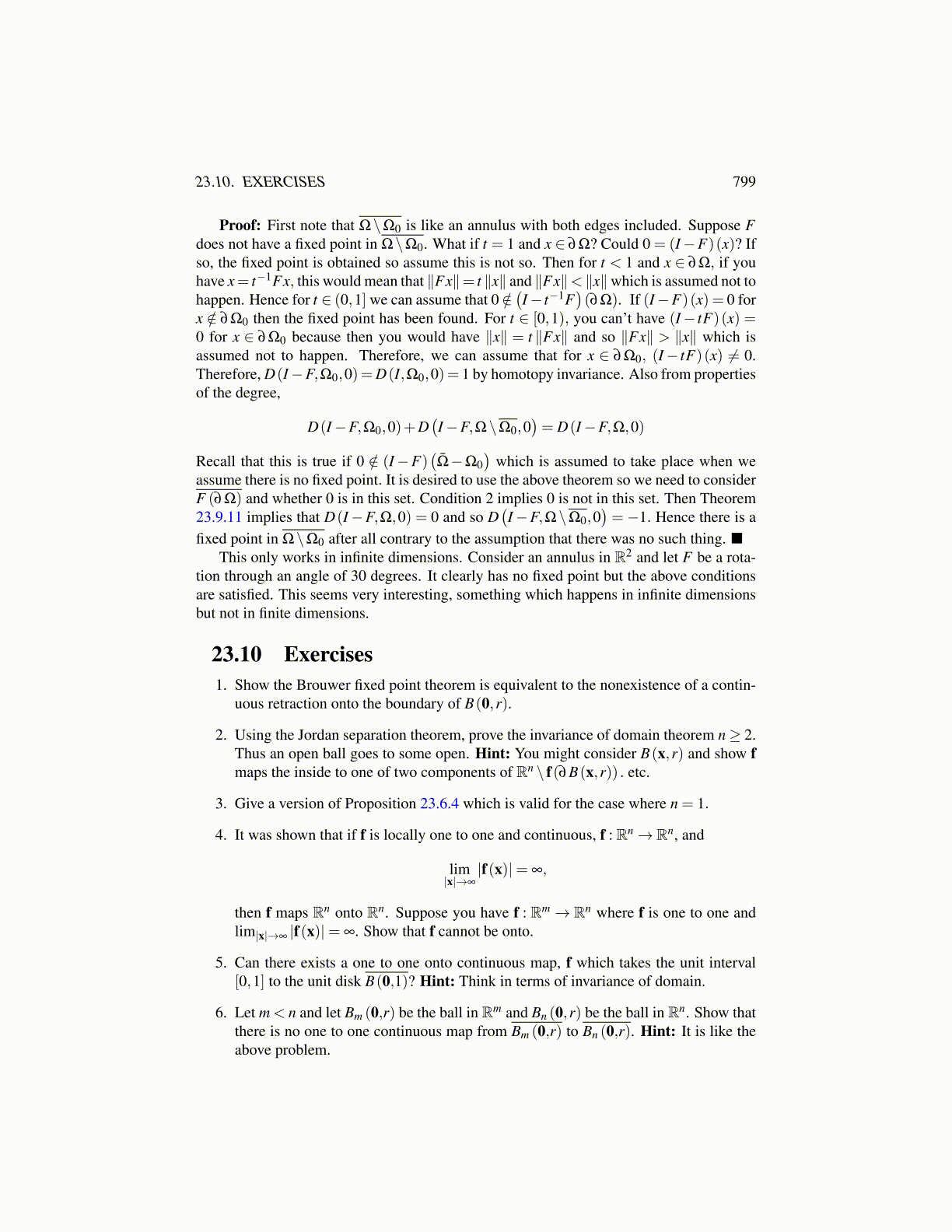
23.10. EXERCISES 799
Corollary 23.9.12 Let X be an infinite dimensional Banach space. Let 0 ∈ Ω0 ⊆Ω be twoopen sets. Let F : Ω→ X be a compact mapping which satisfies
1. ∥Fx∥ ≤ ∥x∥ for x ∈ ∂Ω0
2. ∥Fx∥ ≥ ∥x∥ for x ∈ ∂Ω
Then F has a fixed point in Ω\Ω0.
Proof: First note that Ω\Ω0 is like an annulus with both edges included. Suppose Fdoes not have a fixed point in Ω\Ω0. What if t = 1 and x ∈ ∂Ω? Could 0 = (I−F)(x)? Ifso, the fixed point is obtained so assume this is not so. Then for t < 1 and x ∈ ∂Ω, if youhave x= t−1Fx, this would mean that ∥Fx∥= t ∥x∥ and ∥Fx∥< ∥x∥which is assumed not tohappen. Hence for t ∈ (0,1] we can assume that 0 /∈
(I− t−1F
)(∂Ω). If (I−F)(x) = 0 for
x /∈ ∂Ω0 then the fixed point has been found. For t ∈ [0,1), you can’t have (I− tF)(x) =0 for x ∈ ∂Ω0 because then you would have ∥x∥ = t ∥Fx∥ and so ∥Fx∥ > ∥x∥ which isassumed not to happen. Therefore, we can assume that for x ∈ ∂Ω0, (I− tF)(x) ̸= 0.Therefore, D(I−F,Ω0,0)=D(I,Ω0,0)= 1 by homotopy invariance. Also from propertiesof the degree,
D(I−F,Ω0,0)+D(I−F,Ω\Ω0,0
)= D(I−F,Ω,0)
Recall that this is true if 0 /∈ (I−F)(Ω̄−Ω0
)which is assumed to take place when we
assume there is no fixed point. It is desired to use the above theorem so we need to considerF (∂Ω) and whether 0 is in this set. Condition 2 implies 0 is not in this set. Then Theorem23.9.11 implies that D(I−F,Ω,0) = 0 and so D
(I−F,Ω\Ω0,0
)= −1. Hence there is a
fixed point in Ω\Ω0 after all contrary to the assumption that there was no such thing.This only works in infinite dimensions. Consider an annulus in R2 and let F be a rota-
tion through an angle of 30 degrees. It clearly has no fixed point but the above conditionsare satisfied. This seems very interesting, something which happens in infinite dimensionsbut not in finite dimensions.
23.10 Exercises1. Show the Brouwer fixed point theorem is equivalent to the nonexistence of a contin-
uous retraction onto the boundary of B(0,r).
2. Using the Jordan separation theorem, prove the invariance of domain theorem n≥ 2.Thus an open ball goes to some open. Hint: You might consider B(x,r) and show fmaps the inside to one of two components of Rn \ f(∂B(x,r)) . etc.
3. Give a version of Proposition 23.6.4 which is valid for the case where n = 1.
4. It was shown that if f is locally one to one and continuous, f : Rn→ Rn, and
lim|x|→∞
|f(x)|= ∞,
then f maps Rn onto Rn. Suppose you have f : Rm→ Rn where f is one to one andlim|x|→∞ |f(x)|= ∞. Show that f cannot be onto.